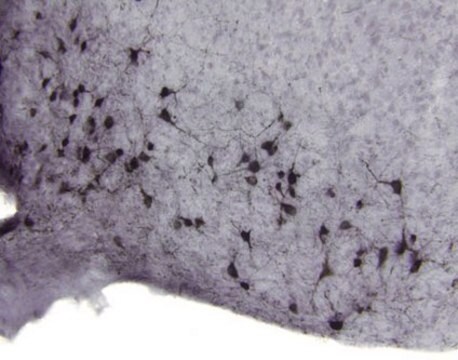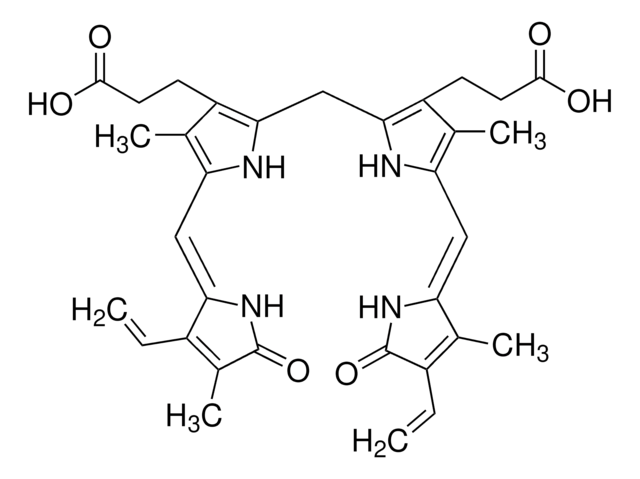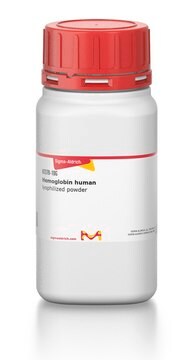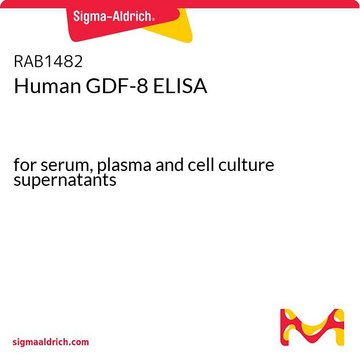M3064
Myostatin human
recombinant, expressed in E. coli, lyophilized powder, suitable for cell culture
Sinonimo/i:
Growth Differentiation Factor - 8
Autenticatiper visualizzare i prezzi riservati alla tua organizzazione & contrattuali
About This Item
Prodotti consigliati
Origine biologica
human
Livello qualitativo
Ricombinante
expressed in E. coli
Saggio
≥95% (SDS-PAGE)
Stato
lyophilized powder
PM
16 kDa (including a 31 amino-acid spacer and 6-His tag)
Confezionamento
pkg of 0.1 mg
tecniche
cell culture | mammalian: suitable
N° accesso UniProt
Temperatura di conservazione
−20°C
Informazioni sul gene
human ... MSTN(2660)
Applicazioni
Use recombinant myostatin to study its mechanisms of action in vitro.
Azioni biochim/fisiol
Myostatin is a 25 KDa, homodimer, that acts on muscle to induce SMAD family transcription factors such as SMAD2 and SMAD3. It inhibits the differentiation of myoblasts into mature muscle fibers. Positive control for myostatin in Western blots and ELISA.
Positive control for myostatin in Western blots and ELISA.
Codice della classe di stoccaggio
11 - Combustible Solids
Classe di pericolosità dell'acqua (WGK)
WGK 3
Punto d’infiammabilità (°F)
Not applicable
Punto d’infiammabilità (°C)
Not applicable
Dispositivi di protezione individuale
Eyeshields, Gloves, type N95 (US)
Scegli una delle versioni più recenti:
Possiedi già questo prodotto?
I documenti relativi ai prodotti acquistati recentemente sono disponibili nell’Archivio dei documenti.
Karima Relizani et al.
Molecular therapy : the journal of the American Society of Gene Therapy, 22(8), 1423-1433 (2014-05-28)
Myostatin regulates skeletal muscle size via the activin receptor IIB (ActRIIB). However, its effect on muscle energy metabolism and energy-dependent muscle function remains largely unexplored. This question needs to be solved urgently since various therapies for neuromuscular diseases based on
H Takahashi et al.
Domestic animal endocrinology, 48, 62-68 (2014-06-08)
The purpose of this study was to determine whether myostatin alters glucose transporter-4 (GLUT4) expression in bovine skeletal muscles and myoblasts isolated from double-muscled (DM) and normal-muscled (NM) Japanese Shorthorn cattle. Plasma concentrations of glucose were lower in DM cattle
Qiang Zhang et al.
The FEBS journal, 277(2), 466-476 (2009-12-18)
The ubiquitin ligase RING finger protein 13 gene (RNF13) was first identified in a screen for genes whose expression is regulated by myostatin in chicken fetal myoblasts. In this study, we demonstrate that the RNF13 gene is broadly expressed in
R E Ferrell et al.
Genomics, 62(2), 203-207 (1999-12-28)
Myostatin is a recently identified member of the transforming growth factor-beta family of regulatory factors, also known as growth and differentiation factor 8 (GDF8). The nucleotide sequence of human myostatin was determined in 40 individuals. The invariant promoter contains a
Yutaka Ohsawa et al.
PloS one, 10(7), e0133713-e0133713 (2015-08-01)
Myostatin, a muscle-specific transforming growth factor-β (TGF-β), negatively regulates skeletal muscle mass. The N-terminal prodomain of myostatin noncovalently binds to and suppresses the C-terminal mature domain (ligand) as an inactive circulating complex. However, which region of the myostatin prodomain is
Il team dei nostri ricercatori vanta grande esperienza in tutte le aree della ricerca quali Life Science, scienza dei materiali, sintesi chimica, cromatografia, discipline analitiche, ecc..
Contatta l'Assistenza Tecnica.








